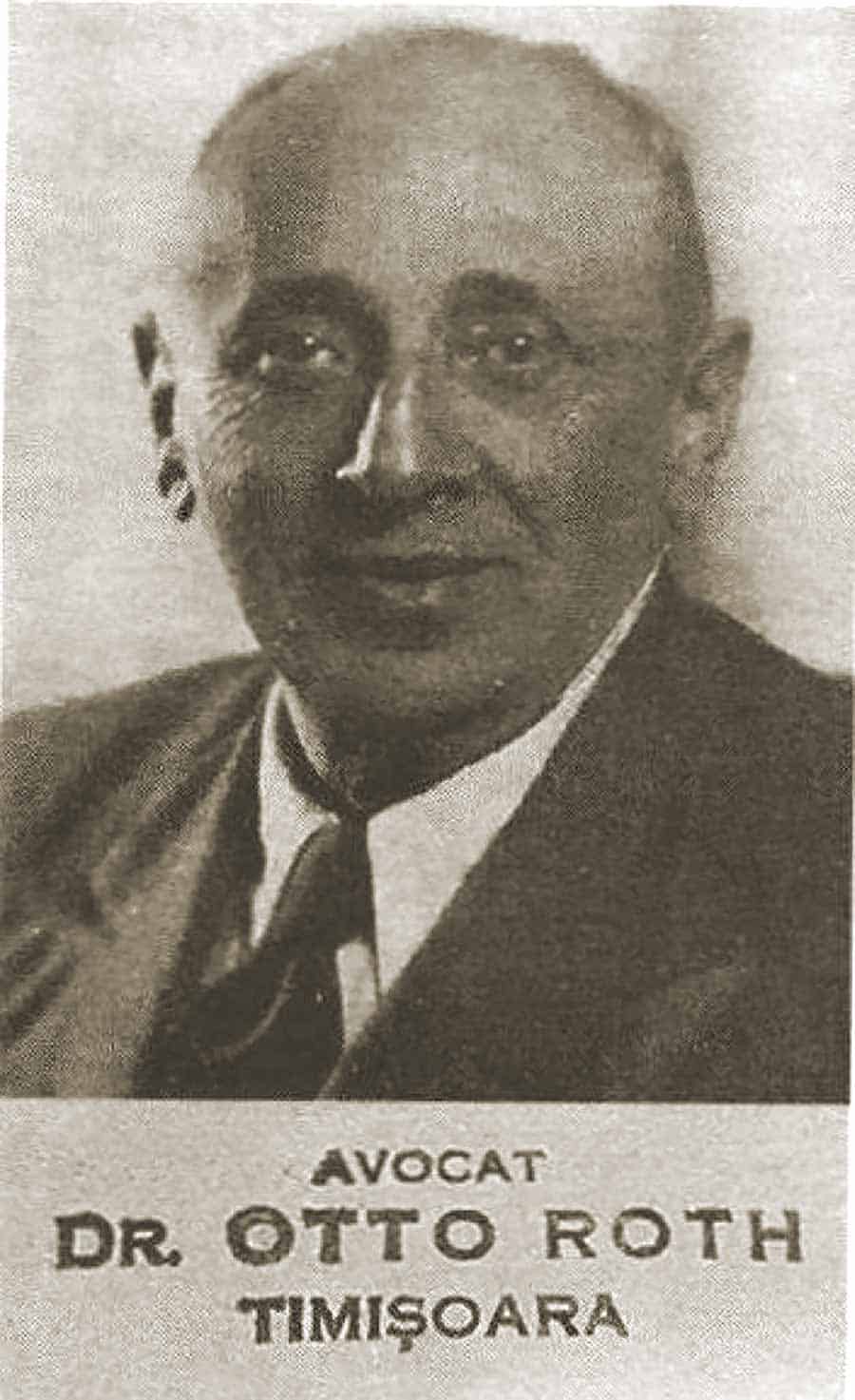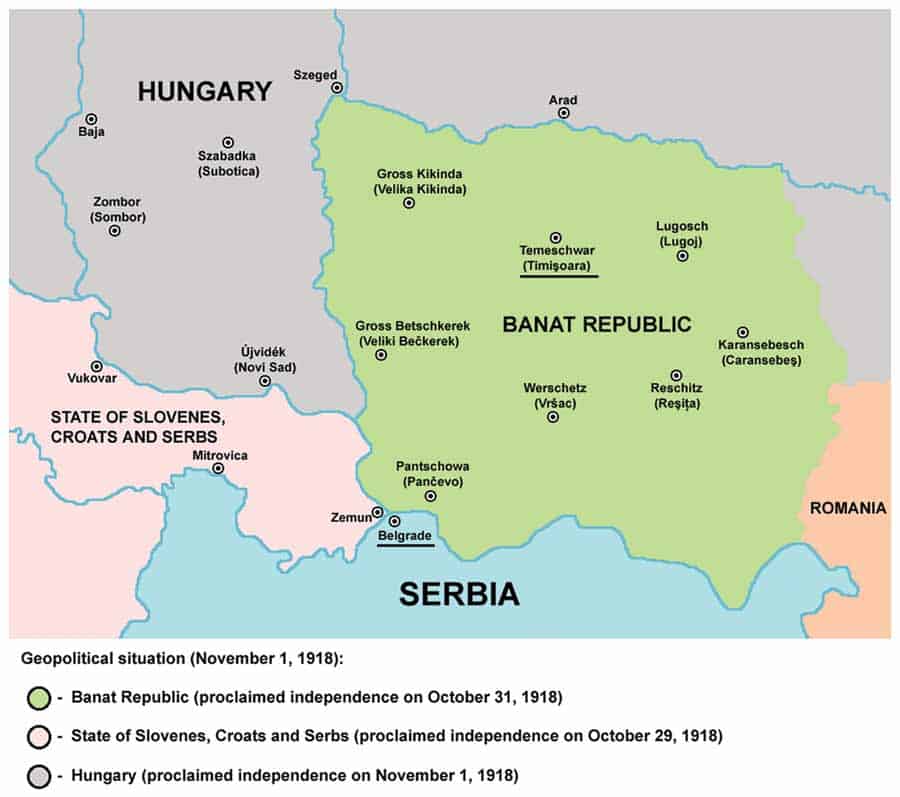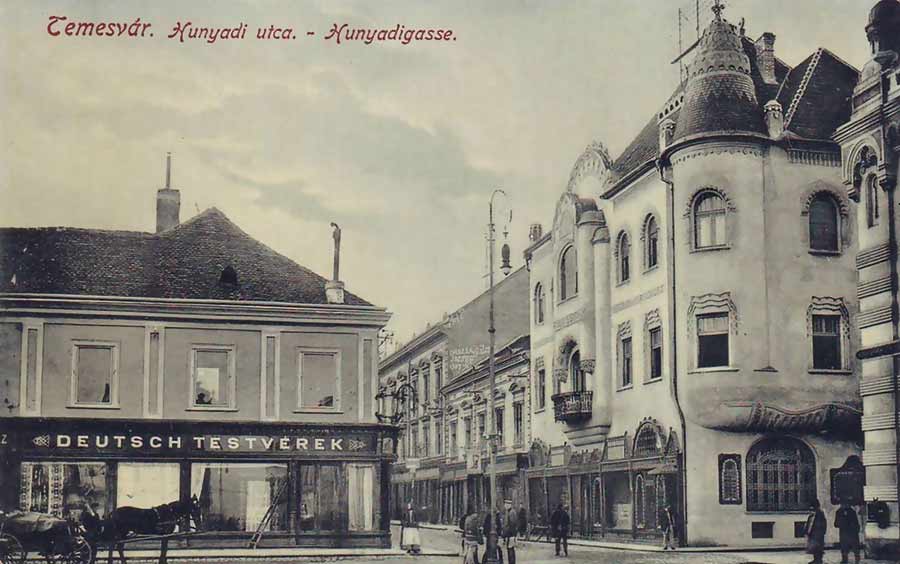November 1st, 1918 – 100 years since establishment of Banat Republic
“Empress Karl and Empress Zita, why are you at war when you have no wheat?!” the farmers from Slavonia used to sing during the last months of the fall of the Austro-Hungarian Empire in the autumn of 1918. At the same time, in the other corner of the monarchy – Banat, to be more precise – a group of Germans, Romanians, Serbs and Hungarians were preparing to establish the Banat Republic.
This was, ethnically speaking, a very heterogeneous territory with about 592,000 (37%) Romanians, 387,000 (24%) Germans, 284,000 (18%) Serbs, 242,000 (15%) Hungarians, and over 50,000 (6%) members of other nations, including Jews, Croats, Slovaks, Bulgarians, and the Roma people. 855,000 inhabitants were Orthodox and 591,000 Catholics. In total, Banat had the population of 1,600,000, slightly less than today’s Vojvodina. Timisoara, the capital city of Banat, had the population of over 72,000 at that time, almost as Belgrade, which had 80,000 inhabitants. Novi Sad had the population of around 33,000. Banat was one of the more developed regions in the then Central and Eastern Europe.

On November 1st, it was exactly 100 years since the renowned German-born politician Otto Roth declared the Banat Republic and its secession from Hungary from the balcony of the Town Hall in Timisoara. Roth, otherwise a Social Democrat, became a Civil Trustee, or, de facto the President of the Banat Republic. Albert Barta was appointed military commander and on the same day, the Banat People’s Council was formed comprising of 20 members of the Timisoara City Council, 60 representatives of national military councils, 40 representatives of workers’ councils and 70 representatives of traditional political parties. The Council immediately elected the Executive Committee, a kind of temporary Government of the Banat Republic that had five representatives of the four largest nations (Romanians, Germans, Serbs and Hungarians). Over the next few days, military detachments and civilian guard were formed by the newly established civilian government taking over the command of the existing national guard. In the meantime, the Austro-Hungarian monarchy officially capitulated on November 3rd.
WOULD FERNINAND BE ASSASSINATED IN NOVI SAD?
Two weeks later, on November 15th, the Serbian Army crossed the Danube and abolished the Banat Republic which civilian authorities continued to function in part until February 20th, 1919. We all know the story of how Pupin had a decisive influence on Woodrow Wilson conceding to the Serb part of Banat joining the Kingdom of Serbs, Croatians and Slovenes. However, a lesser known fact is that a delegation from Banat attended the Paris peace conference in 1919, bringing a proposal to create a new state called Banatia which, in addition to the Serbian and Romanian Banat, would include Bačka. The conceptual creators of “Banatia” were, of course, thrown out of the conference by the representatives of the victors in ’the Great War’ and returned home, to Banat, empty handed.
A hundred years later, the panel discussion titled “Inventory: Vojvodina – 100 Years Since the Annexation and 30 Years Since the Yogurt Revolution” was held at the Matica srpska Gallery, under the auspices of the regional literary conference “Book Talk”. One of the panel’s participants, Tomislav Marčinko, formerly a “pro-autonomy official” from Novi Sad and the head of the HTV Zagreb in the 1990s, began his presentation with the following words: “What would happen to Vojvodina if it gained independence 100 years ago? It would have been a well-regulated small state with about three million inhabitants, multi-confessional, seven times wealthier than it is today, and would be both Europe’s favourite and the hand that feeds it.”

Even if such a state was created in 1918, which was completely impossible, as the ideological creators of “Banatia” found out in Versailles, it would certainly not have survived the Second World War. The fact is that since the revolution of 1848/49, when on June 12th, 1849, Novi Sad was completely razed to the ground thanks to the relentless bombing of the Hungarian garrison, stationed at Petrovaradin Fortress, there were no major ethnic tensions in Vojvodina in the 93-year-period prior to the Second World War.
When a member of the audience at one of the earlier Book Talk conferences asked Aleksandar Gatalica, the author of the novel “The Great War”, if Prince Ferdinand would have been be assassinated if the maneuvers had taken place in the vicinity of Novi Sad and not in Bosnia, he replied honestly, arguing that the Serbs in Vojvodina, at that time, had a satisfactory level of emancipation in all areas, which was not the case with the Serbs in Bosnia and Herzegovina, that was liberated from the Turks only 35 years earlier.
DISAPPEARANCE OF JEWS, GERMANS AND WHITE RUSSIANS
In the Second World War, Vojvodina lost three, at that time, most culturally and technologically advanced national communities – Jews, Germans and White Russians. First, the Jews were killed in the Holocaust by the Ustasha and the Nazis in Srem and Banat in 1941. The Holocaust in Bačka ended in the spring of 1944. In the autumn of the same year, the German locals left their homes somewhat willingly while those German civilians who stayed behind ended up in the camps in Knićanin, Gakovo and Bački Jarak. Many of them did not survive, and most of those who did moved to Germany after the dissolution of the camp in 1948. The same goes for the very few Jews who survived the Holocaust; in 1948, when the state of Israel was founded, the majority of them also moved out of the country. The third community, which almost completely disappeared in the Second World War, was the White Russians who, fearing the retaliation from the Red Army, either withdrew with the Germans, or were also killed after the Soviet troops entered Vojvodina.

So, if such “Vojvodina” or “Banatia” was formed in 1918, it is highly likely that it would not have survived the Second World War. And Serbs cannot be blamed for that in any shape or form. Serbs were certainly not responsible for the raids in Bačka, the killing of Serbs in Srem under the Independent State of Croatia (or NDH) and the Holocaust of the Jews, as “the first blood” that was shed in 93 years (if we exclude minor incidents during the Great War).
Although with the ethnically modified composition, the post-war development in Vojvodina resulted in the province being declared a developed region. In 1987, during the Socialist Republic of Yugoslavia, Vojvodina had the second highest average salary, right after Slovenia. During the aforementioned panel discussion, we also found out that, in the late 1970s, Novi Sad’s GDP was higher than the GDP of the entire Montenegro.
So, how high are salaries in Vojvodina today? According to the latest data collated by the Republic of Serbia’s Statistical Office, the average salary in Vojvodina in August this year amounted to 47,118 dinars, and it was 2,655 dinars lower than the state average for that month.
30 YEARS AFTER ‘YOGURT REVOLUTION’
This is where we come to the second topic of the aforementioned panel discussion, that is the 30th anniversary of the Yogurt Revolution which happened on 5th and 6th October, 1988 and which is branded by many of the local pro-autonomy supporters as the key moment in the downfall of the Vojvodinian economy and infrastructure. The fact remains that centralization had bad effects on the whole country, but this was probably the most pronounced in the very developed Vojvodina. The stories about the clogged and poisoned irrigation canals that were built by the Austro-Hungarian Empire in the late 18th century and the buildings they built which we did not even have the time to paint are part of everyday narratives in the Vojvodinian observations of the 100th anniversary of the Annexation.

So, what kind of future does Vojvodina have in today’s Serbia and Europe? After Maria Theresa moved dozens of thousands of Germans, Serbs, Croats, Slovaks, Czechs and Ruthenians here, following the withdrawal of the Turks from the Pannonian Basin, her grandson built irrigation channels so that the swampy land here could be properly irrigated. It seems that today’s Vojvodina is ready for a new colonization.
Just like back then, in the 18th century, our villages today are almost completely deserted, and our irrigation channels are either clogged or poisoned. However, this time around, the colonists will not come in the so-called Ulm’s Boxes via the Danube, as the Danube Swabians did, or by “trains without a timetable”, like the colonists after the Second World War, or on tractors, like the Serbs leaving the Krajina region in Croatia in 1995. Nobody from Schwarzwald has an even remote intention to move to some Vojvodina far away which has the average salary that is lower than the state’s, that is less then 400 euro. Even people from the mountains of Romanija and Grmeč are not keen on moving to Vojvodina. They would rather live and work in Slovenia, Austria and Germany.
THE TIME HAS COME FOR A NEW COLONIZATION?
So, who actually wants to move to Vojvodina presently? Even the migrants from the Middle East are not staying here. The Danish Refugee Council gives free Serbian language classes and yet none of them have applied. Vojvodina, as well as the rest of Serbia, Bosnia or Croatia, are only transit stations on their way to Hamburg. The only thing I see as a relatively certain solution is that, in accordance with some kind of agreement between the EU and Serbia, Vojvodina will be inhabited by the migrants from Afghanistan and other countries whose population sees the 400 euro wage as a reasonable alternative to living with war, drought and hunger.

The idea of the multinational and multi-confessional “Banatia” from a hundred years ago has failed, among other things, because almost all multicultural projects in the 20th and 21st century in Central and Eastern Europe have collapsed. At the end of the First World War, almost the same number of Muslims, Orthodox, Catholic and Jewish people lived in Sarajevo. Ladino, the language of the Sephardic Jews, was a native language spoken by every seventh citizen of Sarajevo. Today, the population of Sarajevo is 81% Bosniaks, 4% Serbs, 5%Croats and less than 0.5% Jews. The fact remains that Gdansk, Thessaloniki, Rijeka or Tangier were the most prosperous ports in times when they were multicultural cities and had the free zone status. When the 20th century ended, so did such times, both in Europe and in the Mediterranean.
Last weekend, on the corner of Zmaj Jovina and Dunavska streets, in the same spot where the Serbian Army entered Novi Sad on November 9th, 1918, a girl, dressed in the Serbian national costume, was playing the title song from the “Salaš u Malom Ritu” series. One of the lyrics of the song goes – “Our meadows will flourish again, hey, granges of mine, I will be coming back to you”. It remains to be seen whether these lyrics will fall on deaf ears.

Rođen 27.7.1968. u Baču (Vojvodina, Srbija). Srednju školu završio u Bačkoj Palanci, Pravni fakultet studirao u Novom Sadu. Od 1990. radi kao novinar – u početku kao novosadski dopisnik beogradskih “Večernjih novosti”; zagrebačke “Arene”, sarajevskih “Naših dana”. Sarađuje i u magazinima “Vreme” i “Stav”.
1992. sa grupom studenata obnavlja izlaženje studentskog mesečnika “Index”. Posle dva broja sledi smena celokupne redakcije i pokretanje magazina “Nezavisi Index” koji će kasnije 1993. promeniti ime u “Svet” iz kojeg je nastala izdavačka kuća Color Press Grupa.
Danas na čelu Color Press Grupe najvećeg izdavača magazina u regionu sa kompanijama u svih 6 republika – 110 magazina, 25 internet portala i preko 80 konferencija i festivala godišnje.
U porfoliju kompanije pored domaćih (poput magazina “Lepota i zdravlje”, “Svet”, “Pošalji recept”, “Lekovito bilje” itd) nalaze se i brojni licencni brendovi: “The Economist”, “Hello!”, “Gloria”, “Story”, “Star”, “Lisa Moj stan”, “Hausbau”, “Brava Casa”, “Bravo”, “Alan Ford”, “Grazia”, “La Cucina Italiana”, “Auto Bild” i brojni drugi.
